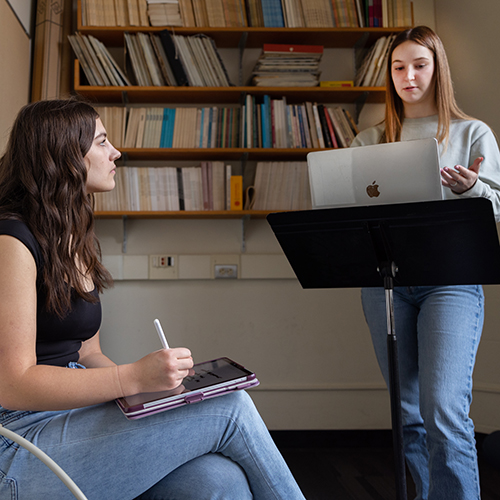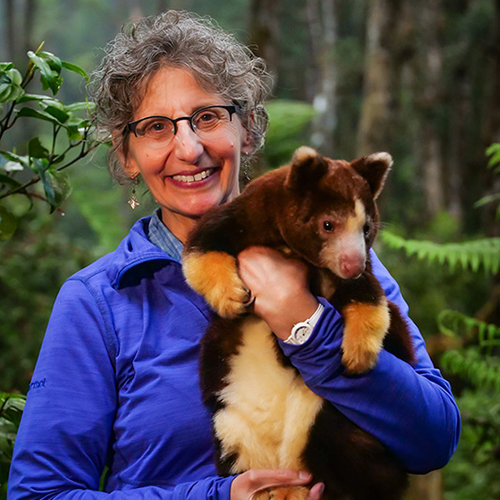David Horsey should send Bill Clinton a thank you note. The president's travails of the past year have provided unusually rich material for Horsey's editorial cartoons, published daily in the Seattle Post-Intelligencer (P-I). Now his scathing cartoons have earned Horsey the 1999 Pulitzer Prize for Distinguished Editorial Cartoons.
"Winning the Pulitzer Prize is a great satisfaction," says Horsey, who earned his B.A. in communications from the UW in 1976. "It's like getting to the top of a mountain after a tough climb. Of course, once you win this, you're very close to being a has-been."
Not likely. Horsey is in top form, with his syndicated cartoons appearing in more than 450 papers nationwide. In addition to the Pulitzer, he's won top awards from the National Press Foundation and the Society of Professional Journalists this year.
From The Daily to the P-I
Horsey has always liked to draw. He's also had an interest in politics since childhood—a result of his father's influence. "My dad would bring me along to lots of events," recalls Horsey. "He was a staunch Republican. My earliest political memory is of an Eisenhower election celebration when I was five years old. I also joined my father at the Republican Convention in San Francisco in 1964."
By high school, Horsey had combined his two interests and was drawing editorial cartoons for his school's newspaper in Seattle. "That's where I did my first political cartoons--everything from picking on the school's P.E. teachers to the Vietnam War," he says. At that time, Horsey's political views mirrored his father's, and he describes his cartoons as "pretty conservative stuff."
All that changed when Horsey arrived at the UW. Vietnam War protests were heating up, with the Kent State uprising feeding the fire. "My politics started shifting," recalls Horsey.
During his freshman year, Horsey joined the staff of The Daily--the UW's student newspaper--as an editorial cartoonist. He later became editor of the paper, which led him to pursue a journalism degree. "I started out as a graphic design major," he explains, "but being editor of The Daily convinced me that I really liked newspapers. That's when I switched to communications."
By the time he graduated from the UW, Horsey had an impressive portfolio of cartoons lambasting everything from Richard Nixon to corporate greed. But neither of Seattle's daily papers had editorial cartoonists on staff, so Horsey decided to become a reporter instead.
"I liked reporting as much as drawing," he explains, "so I went to work at the Bellevue Journal-American, where I covered the state legislature. I'd had an internship in Olympia through the School of Communications that prepared me really well."
Horsey's return to cartooning came via a UW connection. The Seattle Times hired an editorial cartoonist and the P-I decided to follow suit. Horsey's former adviser at The Daily, Bill Asbury, was now managing editor of the P-I and called Horsey to see if he was interested in the job. "It didn't take me long to decide," says Horsey, who also writes occasional opinion columns for the paper. "I'm more comfortable as an editorialist, expressing my own opinions. I don't think I was a great reporter, but I am good at commentary."
An Insider's Perspective
Since joining the P-I in 1979, Horsey has been to every New Hampshire presidential primary. He has attended all but one national political party convention. He spent a year in Washington, D.C. to take a closer look at Congress and the White House. And traveled to the Olympics in Atlanta. And went on special assignment in Japan. And visited Brussels as part of a European Union program. Why all the travel, when most editorial cartoonists rarely leave their desks?
"I got into this by being a reporter," he explains. "And the thing I liked about being a reporter was the voyeuristic aspect--being on the inside of events. I think it makes my cartoons better when, instead of working off of other people's impressions, I develop my own. It also helps keep me excited about the job."
The New Hampshire primary has been a particular favorite of Horsey's because of its intimacy. He recalls spending an entire afternoon in the presence of Bill Clinton, "watching him talk to people in a shopping mall next to an Orange Julius stand. It gave me real insight into him before anyone knew who he really was."
What Horsey couldn't know was that Clinton would be at the center of a major scandal during his presidency and the inspiration for literally hundreds of cartoons. Of course, this was nothing new for Horsey, who'd already skewered Nixon during the Watergate era. He also relished the Reagan years, which he says rivaled the Nixon and Clinton years for material.
Choosing Metaphors Carefullly
Presidents are obvious targets for editorial cartoonists, but Horsey also tackles other hot issues of the day, some of which can be highly controversial. He's come to expect angry phone calls on occasion, especially following cartoons on religion, abortion, or race. He knows it comes with the territory.
"Cartoons are a collection of symbols," he says. "Most of the time, I'm looking for a metaphor that will fit the topic--some common symbol or image that can be twisted and turned to say what I want to say. The only problem is, those symbols and images can mean different things to different people. People can read things in a lot of different ways. If they are going to get mad at me, I want them to get mad at what I really meant to say. So I have to choose my metaphors carefully."
Fortunately, Horsey feels prepared to address nearly any issue that comes along, thanks to his liberal arts education at the UW. "I'm expected to comment on virtually anything that happens from the City Council to China to the NRA," he explains, "so having a sense of culture and history is vital to doing this right. I'm glad that I indulged myself in a broad education at the UW--from history and politics to art history and literature. I think being able to wander through the riches of civilization really gave me the Renaissance mind that's required to do editorial cartoons."
More Stories

The Truth About Public Speaking
Becoming an effective public speaker requires planning and practice. Professor Matt McGarrity and consultants at the UW Center for Speech & Debate are available to help.

Mentorship for Black Professionals, Earbuds Not Included
Identity Unboxed, a podcast created by alums Tiana Cole and Brad Blackburn III, explores the experiences of Black professionals in the Seattle area.

Protecting Ghosts of the Forest
Lisa Dabek (PhD, Psychology, 1994), senior conservation scientist at the Woodland Park Zoo, studies and protects tree kangaroos in the cloud forests of Papua New Guinea.